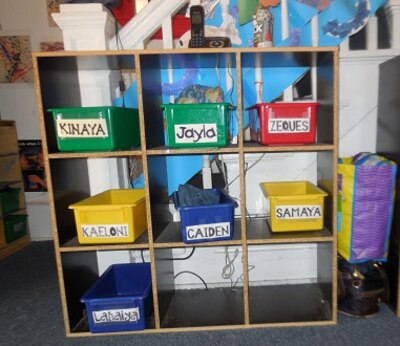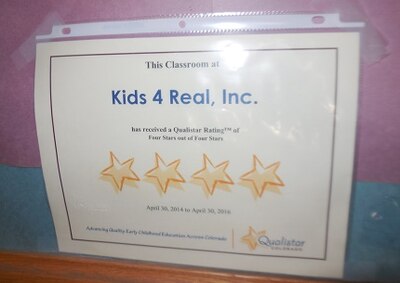Last fall, Roman Hollowell contemplated closing the small child care center he runs out of the first floor of his childhood home in Denver’s Whittier neighborhood. Enrollment at “Kids 4 Real, Inc.” was dwindling and he didn’t know if he could keep the lights on for much longer.
It was a tough decision for Hollowell. His mother Oneta had opened the center in 1993 and run it for nearly two decades until she died of a rare form of cancer in 2012. Although he’d never envisioned himself in the child care field, he was reluctant to abandon the business his mother began building when he was a sports-loving high school kid.
“It was important for me to continue her legacy,” said Hollowell on recent Monday morning at the center. “Something just kind of told me to hang in there and stay the course.”
What helped turn his intuition into action was a program called Early Learning Ventures Shared Services model, or ELV. The non-profit, launched in 2009 by the David and Laura Merage Foundation, aims to help Colorado child care providers save time and money by giving them the tools to operate more efficiently. In exchange for access to ELV’s web-based platform, providers pay a monthly fee ranging from $50 to $250.

For many of the 556 licensed child care providers participating across that state, the program means discounts on supplies and services, online training for staff, computerized child-tracking systems, help with licensing documentation, and ready-made templates for things like parent handbooks. What helped Hollowell last fall however, was one of ELV’s marketing tools, which gave him access to the addresses of families with young children living near the center.
“That was amazing,” he said, perched on a blue-kid sized chair near shelves full of puzzles and games. “I was able to get my hands on 1,000 plus addresses.”
Hollowell subsequently sent out 400 letters advertising “Kids 4 Real” and enrollment picked up enough to keep the doors open.
A quality improvement strategy
Shared services is a relatively new approach in the early childhood arena, but one that is gaining momentum both in Colorado and nationally. Proponents believe the model will ultimately help providers—often small mom and pop shops—shed inefficient back-office practices so they can save time and money.
“The idea is not just to make director’s lives easier,” said Jonathan Godes, executive director of the Early Childhood Network in Glenwood Springs. “The idea is they take those time saving and money savings and reinvest them into the program.”
Shared services fits with the nationwide push to improve the quality of early childhood care and education, especially for low-income children. Currently, there are shared services efforts in about a third of states, though details—from the sponsoring organization to fee structures–vary widely.
“There are folks all across the country that are experimenting with shared services,” said Louise Stoney, co-founder of the Alliance for Early Childhood Finance and the Opportunities Exchange, a consulting group dedicated to advancing shared services alliances.
“Shared services is still a very new and unique movement in general,” she said.

In Colorado, ELV leaders have big plans for the program, which cost around $7 million to build and administer. In addition to eventually enrolling 2,050 Colorado centers, they hope to become financially self-sustaining by the time they reach 1,950. They also hope to expand the ELV model to other states.
Currently under ELV’s model there are six regional alliances in Colorado. Each alliance is run by a local non-profit, which recruits providers to participate and helps them learn the platform. ELV’s Englewood headquarters provide financial and technical assistance to each alliance.
Providers interested in participating in ELV can sign up for one of three levels of service. So far, there are 485 providers in Tier 1, which offers basics such as purchasing discounts and online training. Tier 2, which adds a computerized child-management system and other services, has 57 providers and Tier 3, which adds billing and financial services, has 15.
Stoney said ELV’s Tier 3 offerings are one of the program’s distinctive elements.
“There’s really not anyone else in the country that’s doing the same thing,” she said. “It’ll be very interesting to see what kind of uptake they get.”
Their passion is children not accounting
While many other industries, including K-12 education, have robust administrative systems in place, early childhood is an exception. A look at the numbers tells part of the story.
In contrast to Colorado’s 178 school districts, there are more than 4,000 licensed child care providers that provide regular care for the 0-5 set. To be sure, some are large programs run by school districts, national chains or sophisticated non-profits that may have specialized finance and operations staff. There are also some that use “off-the-shelf” products that provide some of the same services as the ELV platform. Still, there are huge numbers of small, independent providers that rely on shoestring budgets and paper-and-pencil methods.

Most get into the field because they love working with children, but the business side of the job can be a “real shock,” said Emily Bustos, executive director of Denver Early Childhood Council and board president of the Early Childhood Councils Leadership Alliance.
“That becomes the most challenging and time-intensive part of running a child care business,” she said.
In many cases, administrators rise to their positions through the teaching ranks and so while they may understand child development, they lack expertise in accounting, payroll, human resources and the regulatory environment.
“They just get thrown in and it’s kind of sink or swim,” said Godes, whose organization runs one of ELV’s six alliances.
There are plenty of anecdotes about rampant inefficiencies in the small preschools, child care centers and family child care homes that dot the early childhood landscape. Some providers go through the tedious process of hand tallying numbers for food program reimbursements or piecing together attendance records from paper sign-in sheets that some parents inevitably forget to fill out. Even drafting a parent letter when there’s a lice outbreak or a biting incident can turn into a time-consuming task.
Judy Williams, ELV’s program director, told of one rural child care center where the director and a staff member used to spend an entire day every month traveling to Denver to shop at Costco for supplies. It may have been cheaper than shopping local stores, but it cost far more than ordering supplies through ELV’s platform and getting next-day shipping.
Ultimately, many of these long-held practices either drain the budget or suck away the director’s time, keeping her busy with paperwork instead of working with teachers and kids in the classroom. That’s what happened to Kelly Esch when she became the director of the Little Red Schoolhouse in Snowmass Village last year.
She was working 50 hours a week, most of that shut away in her office. Since she began taking greater advantage of ELV’s tools, she’s cut her office work down to 30-35 hours, allowing her to spend more time assisting teachers, giving them breaks and helping them with lessons and activities.
“That way, they’re not so stressed out,” she said. “When you’re in the classroom 10 hours a day it’s hard to come up with fresh ideas,” she said.
Kathryn Hammerbeck, executive director of the Early Childhood Education Association of Colorado, believes ELV’s model may also help address her members’ most pressing problem: attracting and retaining high-quality employees.
“If you can control some of your overhead, some of your operational cost, then it frees it a little money to put into wages, which will help you attract and retain staff.”
At what price?
While many providers have gotten scholarships or partial scholarships to participate in ELV, especially for their first year, the prospect of eventually paying a monthly fee can be daunting.
“Early childhood education is a very, very price sensitive program,” said Stoney. “This is not a money-making field. It’s very, very difficult to charge fees for things.”
Currently, about 22 percent of participating providers receive full or partial scholarships to participate. In addition, the state plans to chip in about $500,000 for Tier 2 ELV scholarships over the next 14 months using federal Early Learning Challenge Grant money. The one-year scholarships will target 100 “high needs” providers that serve low-income children and English language learners, and generally do not have a quality rating from Qualistar.
Colin Tackett, business analyst at the Colorado Department of Human Services, said the hope is that the initial subsidies will allow providers to see the benefits of ELV and subsequently continue participating on their own dime.
According to a recent third-party return-on-investment study, there are concrete financial benefits to participating inELV, particularly for center-based programs. The results show that centers would save $84,000 to $114,000 over five years depending on which ELV tier they were in. The savings were smaller for home-based providers, with a five-year return of $270-$1,270.
Among current participants, there’s generally a feeling that the program generates significant financial savings. Hollowell, who has a partial scholarship for Tier 2 of ELV, said he pays $25 a month and realizes savings of about $100-150 a month, mostly due to discounts on office supplies and other equipment.
Esch, who pays $75 a month and has a scholarship to pay the other $100 for Tier 2, estimated similar savings. When other directors ask her if it’s worth it, her go-to example is the paper towel discount.
“I don’t know if you’ve ever bought industrial paper towels, but they’re extremely expensive and kids use them like crazy,” she said.
Sticking points
While Early Learning Ventures certainly has many enthusiastic advocates, it can be a tough sell in some quarters of the early childhood world. Some providers are wary of one of its central themes—using technology to streamline and modernize operations.
“This is a big leap for them,” said Williams, a former child care provider herself.
Aside from the inevitable anxiety or confusion about web-based tools, there’s also the challenge of getting time-crunched administrators grappling with major state-level changes—including the launch of a new mandatory quality rating system later this year—to explore a voluntary program that costs money up front.
While Bustos believes there is a market and demand for ELV, she said the benefits must be clearly spelled out for providers.
“There’s way more hand-holding than you realize…to get someone to that next level of sufficiency.”
That point is not lost on Hammerbeck, who in January signed a contract with ELV to offer Tier 1 services as a benefit to members. Although it’s free for the 400 preschools and child care centers that belong to the association, she said only about 10 providers representing 25 sites have signed up.
“It’s a question of educating them…they don’t have the time to sit and read the information we sent them about it.”
Still, she said, ““It would help them so much in running their program.”
Doing mom proud
Just inside the front entrance of Kids 4 Real is a large framed photograph of a smiling Oneta Hollowell. Underneath it is a bulletin board featuring one of Roman Hollowell’s proudest accomplishments. It is a plastic-encased certificate showing the center’s four-star quality rating by Qualistar.

That rating, the highest currently awarded, replaced the center’s previous three-star rating a couple months ago. Hollowell said meticulous preparation, including a walk-through by an ELV program manager, helped him get the points he needed.
“I was able to be hands on,” he said. “Our preparation in 2014 was perfect.”
It’s impossible to know whether Hollowell’s use of ELV’s purchasing discounts, its computerized sign-in/sign-out system, its address lists or anything else was critical to the four-star rating. Perhaps it all factored in to the equation.
What’s clear is that Kids 4 Real realized exactly the type of improvement ELV leaders hope to see on a broader scale in the years to come.

